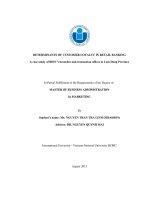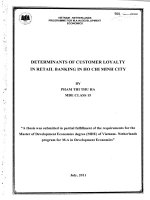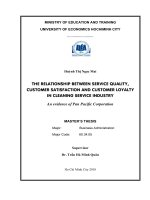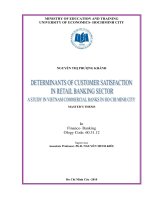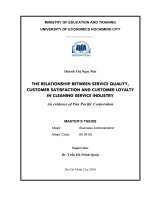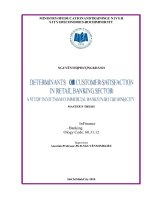Determinants of customer satisfaction in retail banking sector Luận văn thạc sĩ
Bạn đang xem bản rút gọn của tài liệu. Xem và tải ngay bản đầy đủ của tài liệu tại đây (689.85 KB, 84 trang )
MINISTRY OF EDUCATION AND TRAINING
UNIVERSITY OF ECONOMICS- HOCHIMINH CITY
NGUYN TH PHNG KHÁNH
MASTER’S THESIS
In
Finance- Banking
Ology Code: 60.31.12
Supervisor
Associate Professor. Ph.D. NGUYN MINH KIU
Ho Chi Minh City -2010
TABLE OF CONTENT
LIST OF FIGURES i
LIST OF TABLES ii
LIST OF ABBREVIATION iii
ABSTRACT iv
CHAPTER 1 : INTRODUCTION 1
1.1 Rational of the study 1
1.2 Statement of the problem 2
1.3 Research Objective 3
1.4 Research question 3
1.5 Scope and limit of the research 3
1.6 Research methodology 4
1.7 The structure of the research 4
CHAPTER 2 : LITERATURE REVIEW 6
2.1 Vietnam retail banking sector 6
2.2 Customer satisfaction 9
2.2.1 Expectation of customer 9
2.2.2 Definition of customer satisfaction 9
2.2.3 The importance and benefits of customer satisfaction 10
2.3 Customer Service quality 11
2.3.1 Customer service 11
2.3.2 Service characteristics 12
2.3.3 Service quality definition 12
2.3.4 Gap model of service quality 13
2.3.5 Measuring service quality 14
2.4 Customer satisfaction and service quality in banking sector 16
2.4.1 Customer satisfaction in banking sector 16
2.4.2 Service quality dimensions in banking sector 16
CHAPTER 3 : RESEARCH DESIGN 20
3.1 Research model 20
3.1.1 Proposal of research model 20
3.1.2 Initial hypotheses 20
3.2 Research design 22
3.2.1 Research purpose 22
3.2.2 Research approach 22
3.2.3 Research process 23
3.3 Official research 24
3.3.1 Measurement scale 24
3.3.2 The questionaire design 26
3.3.3 Research sample 26
3.3.4 Sampling 27
3.3.5 Size of sample 27
CHAPTER 4 : DATA ANALYSIS AND FINDINGS 28
4.1 Sample Characteristics 28
4.2 Statistical Results 30
4.2.1 Variables for measuring service quality 30
4.2.2 Variables for customer satisfaction 31
4.3 Data Analysis 32
4.3.1 Reliability evaluation through Cronbach’s Alpha 32
4.3.2 Evaluation the measurement scale by using Exploratory Factor Analysis 34
4.3.2.1 Some rules in EFA test 34
4.3.2.2 EFA for service quality 34
4.3.2.3 EFA for customer satisfaction 38
4.3.3 The adjusted research model 38
4.3.4 Modeling Testing 39
4.3.4.1 Correlation coefficient analysis 39
4.3.4.2 Regression Analysis 40
CHAPTER 5 : CONCLUSIONS AND RECOMMENDATIONS 44
5.1 Conclusions 44
5.2 Recommendations 45
5.3 Research limitation 47
REFERENCE 48
APPENDIX 51
APPENDIX 1: Interview Customers 51
APPENDIX 1: Questionaire 52
APPENDIX 2: Vietnamese questionaire 56
APPENDIX 3: Cronbach's alpha analysis result 60
APPENDIX 4: Factor analysis result 62
i
LIST OF FIGURES
Figure 2.1 : The Benefits of customer satisfaction 11
Figure 2.2 : Model of service quality gaps (Parasuraman at el., 1985) 14
Figure 3.1 : Suggested research model 20
Figure 3.2 : Research process 23
Figure 4.1 : Adjusted research model 38
ii
LIST OF TABLES
Table 2.1 : Quantity of banks from 1991 to 2009 6
Table 2.2 : Six dimensions of service quality 19
Table 3.1 : Summary of service quality factors and measurement scale 24
Table 3.2 : Overall customer satisfaction and measurement scale 26
Table 4.1 : Sample characteristics 29
Table 4.2 : Descriptive statistics of service quality measurement 30
Table 4.3 : Descriptive statistics of customer satisfaction measurement 31
Table 4.4 : Reliability test of service quality and customer satisfaction 33
Table 4.5 : First EFA analysis result of service quality 35
Table 4.6 : Final EFA analysis result of service quality 37
Table 4.7 : Final EFA analysis result of customer satisfaction 38
Table 4.8 : Pearson correlation matrix 40
Table 4.9 : Model Summary
b
41
Table 4.10 : ANOVA
b
41
Table 4.11 : Coefficients
a
42
1
CHAPTER 1 : INTRODUCTION
1.1 Rational of the study
Financial institutions, particularly banking plays an important role in economic
development of almost countries in the world and Vietnam is not an exception.
Vietnam banking industry has gained a significant growth in recent years a long with
the socioeconomic development. Many banks have been established or extended their
range of activity by setting branches in nationwide and offered new services toward
customer’s need. Retail banking in Vietnam is one of the sectors getting more
attractive from domestic banks or even foreign banks with the potential market has not
been exploited full enough so far.
A lot of people among 86 million Vietnamese people have demands for retail
banking services which are going up following the increasing income and the growth
of the country in recent years especially after Vietnam became a member of WTO.
This is the chance as well as the challenge period for bankers in Vietnam to attract the
new customers and retain the existing one. The more customers banks have, the more
profits they get.
Satisfying customers is the priority target in order to get the success of a firm.
Customer satisfaction is one of the key factors in today’s highly competitive business
world and is the most important factor for bankers to keep their current customers as
well as appeal the new one.
In addition, retail banking industry is facing a stressful competition among
domestic banks and foreign banks as the globalization and world integration.
Therefore, banks should pay more attention to customer satisfaction to survive and
grow.
2
1.2 Statement of the problem
Domestic banks have recognized the important to develop retail banking
services for some time now. They have invested in core banking software, applied new
technology, established more branches, provided new services to get more customers.
In modern competitive environment, however, the increasing of distribution
channels set up from all banks, the products in this market are slightly different and the
new services provided are matched very quickly by competitors make banks in
difficulty to create the differentiation. Customer satisfaction is one of the main tools
for banks to make and get competitive advantage.
In general, when customer is satisfied with provided services, the probability to
use this service again is increased and will lead to the positive advertising through
mouth advertising from this customer to others. And vice versa, the unsatisfied
customer usually switches to use another brand and give out the negative mouth
advertising.
There are many factors impact on customer satisfaction. Customer satisfaction
is influenced by main factors such as price, product quality, service quality, personal
factor, situational factor, diversification and the unique of products.
According to Lewis (1993), service quality is one of the effective means in
building a competitive position in service industry. Service quality is an imperative
element impact on customer satisfaction in banking industry. Thus, bank management
tends to differentiate their products from competitors through service quality.
This study examines determinants on customer satisfaction with focus on
service quality dimensions of retail banking services in Vietnam commercial banks in
Ho Chi Minh City where is the center of developing economy, society and education
in South Vietnam with a large number of population, almost banks and their branches.
3
1.3 Research Objective
The aims of this study as following:
- To identify main factors of customer’s perception on customer service quality
in Vietnam retail banking sector.
- To measure the effects of these key factors on the overall customer satisfaction
in Vietnam retail banking sector.
- To recommend some solutions to increase customer satisfaction.
1.4 Research question
The study is set to answer following questions:
- What are the key factors of customer’s perception on service quality of retail
banking services in Vietnam commercial banks?
- How can these factors influence on customer satisfaction?
- What the recommendations should be needed to improve customer satisfaction
in Vietnam commercial banks?
1.5 Scope and limit of the research
Due to the limited time, this research is conducted to the individual customers
who are now living in Ho Chi Minh City and using retail banking services of seven
Vietnam commercial banks in Ho Chi Minh City only. The conclusions will be derived
from this research are limited to Vietnam commercial banks and will be based on the
information of this result.
4
1.6 Research methodology
Secondary data
Data was collected from annual Vietnam commercial banks reports, from
internet, involved books and previous related research.
Primary data
Qualitative research: This step is researching by in-depth interviews with
customers in order to discover and adjust the service quality dimensions. Thirty (30)
customers are using retail banking services at commercial banks were interviewed
directly through questions relating to which factors influence on their satisfaction
when they use retail banking services at banks and which factors made them feel
dissatisfaction. Almost their opinions concentrate on factors including: tangibles,
service quality (showing through employee’s attitude, employee’s willing to help
customers), reliability (showing through employee’s ability to serve customers,
provide exactly information and services as set time), empathy, technology, waiting
time, interest rate and transaction cost. The result of this research is used for designing
the questionnaire used for official study.
Quantitative research: This step is researching by delivering questionnaire to
individual customers of seven commercial banks in Ho Chi Minh City directly, via
email and internet. The collected data is used for analyzing the level of customer
satisfaction through statistical software SPSS version 16.0.
1.7 The structure of the research
This research includes five chapters:
Chapter 1: Introduction
This introduction gives an overall view of the research includes the rational of
the research, statement of the problem, research objectives, research questions, scope
and limit of the research and research methodology.
5
Chapter 2: Literature review
This chapter gives a brief introduction about Vietnam retail banking industry
and general view of theories related to customer satisfaction, five gaps of service
quality, service quality and some results of previous studies about dimensions of
service quality in banking sector.
Chapter 3: Research Design
This chapter develops the research model and hypotheses. In addition to, we
focus on research process and methodology for data analysis.
Chapter 4: Data analysis and findings
This chapter illustrates the process of data analysis and shows the result of this
research from that we can explore the result and discussion.
Chapter 5: Conclusions and recommendations
This chapter summarizes the most important findings, provides
recommendations on how to improve customer satisfaction on retail banking services
of Vietnam commercial banks. Lastly, we show the limit of this research and suggest
for the further research.
6
CHAPTER 2 : LITERATURE REVIEW
2.1 Vietnam retail banking sector
Vietnam banking system has significant growth during past two decades
together with the economic development. This system includes one Vietnam bank for
social policies, one Vietnam development bank, three commercial state-owned banks,
forty commercial joint-stock banks, five joint-venture banks, five 100% foreign banks
and 36 branches of foreign banks.
Table 2.1: Quantity of banks from 1991 to 2009
Year 1991 1993 1995 1997 1999 2001 2005 2006 2007 2008 2009*
Commercial state-owned bank
4445555554 3
Commercial joint-stock bank
44148 51 483937 34 3539 40
Joint-venture bank
1344444555 5
Foreign bank and
branches of foreign bank
0 8 18 24 26 26 29 31 41 41 41
(Source: SBV)
(
2009*: Oct 2009)
We can see from above table 2.1 that the development primarily concentrates
on commercial joint-stock and foreign banks showing the attractiveness and potential
development of Vietnam banking sector to inland investors as well as international
financial institutions, in which retail banking sector is considered as promising land
appeals all bankers.
According to Wikipedia, retail banking refers to banking in which banking
institutions execute transactions directly with consumers rather than corporations or
other banks. Retail banking is usually made available by commercial banks who are
financial institutions and geared primarily toward individual consumers through a wide
range of personal banking services include: deposit accounts in the form of savings
and checking accounts and certificates of deposit of varying maturities; loans in the
form of mortgages as well as personal loans; debit cards, credit cards and so forth.
Today much of retail banking is streamlined electronically via Automated Teller
7
Machines (ATMs); or through virtual retail banking known as internet banking which
allows customers to do financial transactions via internet, home banking allows
customers do almost transferring transactions (money transfer, funds transfer, bill
payment, …) at any where without coming to the bank, and phone banking allows
customers do transactions every where at any time through telephone such as checking
account information, foreign exchange rate, interest rate,….
In the open economy, retail banking services play an important role in bringing
stable source of revenue, enhancing competitive capacity, reducing risk and expanding
market share to commercial banks. In the economic aspect, retail banking sector still
bring benefits in reducing transaction cost; changing to non-cash using economy;
boosting business activities and enhancing people’s life through exploiting and taking
full advantage of potential capital. Moreover, it offers the diversified services to
people conveniently and safely. Therefore, developing retail banking services is an
unavoidable trend of international banks as well as Vietnam banks.
Vietnam is considered as an attractive retail banking market as the whole
market potential, it is clear that there is a huge opportunity for new entrants.
Firstly, it has a strong reputation for both political stability and a prosperous
business environment among Asian nations and became a member of WTO in Jan
2007, under which Vietnam committed to integrate into the world market resulted in
the five 100% foreign banks currently established in Vietnam.
Secondly, Vietnam has a large number of population with the income become
higher every passing day but the amount of people who have bank transaction and
bank account are not much, even some more people in rural areas don’t know about
retail banking services. For instance, Ho Chi Minh City where have a large population
and high bank density is one of the strategic and potential market of retail banking
services gets only 17% of population has bank account and non-cash transaction.
Thirdly, the country’s population around 86 million people, of which young
people aged less than 33 who often change their shopping behaviors account for over
60%. This is the basic for foreign banks as well as domestic banks focus on developing
credit services. In reality, Vietnam commercial banks have offered around 10% of total
8
retail services supplied by international banks to their customers and get back from 6%
to 12% at average turnover from this sector while this rate in developed country is
around 50%. Therefore, there is still available market which attracts more competitors.
The competition among domestic banks, the effort to keep and grow market
share, especially the participant of more foreign banks put retail banking sector under
tremendous competition. With the current capital at thousand million VND, domestic
banks are judged as very small banks compare with others in the region. The State
bank has recognized the situation and required domestic banks must increase their
chartered capital to at least 3 million VND till the end of 2010. Following this, market
will form a trend as amalgamation of business in which small banks will find and
associate with large banks based on mutual benefit to meet the State bank requirement
and confront with market’s challenges. Moreover, the poor of services offered, the
weak of competitive competence make retail banking sector be hard to scope with the
challenges in the market. In the mean time, foreign banks and branches of foreign
banks in Vietnam mostly come from top 1000 large banks in the world who have big
resources, long time experiences, more services with high quality and advanced
technology compare to domestic banks. In the fight against competitors to gain market
share recent years, domestic banks have gone through significant improvement such as
investing modern technology, changing management structure, speeding up
advertising, diversifying distributing channel and expanding networking. They have
specially concerned about diversifying and creating new services which mainly focus
on integrated technology services as cards services, home banking, internet banking,
savings accounts, consuming loans in order to meet the demand of sophisticated
customers. In terms of the numbers of branches, Agribank is the largest organization
with 115 locations, BIDV has 103, VBSP has 65, VDB has 62 and MHB has 32. For
the joint stock commercial banks, the organizations have over 25 branches include
Maritime commercial joint-stock bank (26 branches), Techcombank (38 branches),
VIB (42 branches), Sacombank (59 branches), Eximbank (35 branches), ACB (54
branches) and EAB (28 branches). None of the joint venture banks have more than
five branches (Commercial bank report, 2010).
9
The retail banking market is continuing to evolve and undergo significant
market change. Increasing competition, product and service diversification and greater
online channel usage have resulted in a need for Vietnam commercial banks to deepen
relationships with existing clients as well as attract and convert prospects.
2.2Customer satisfaction
2.2.1 Expectation of customer
Customer expectation is the ideals or feelings that a customer has about the
product or service provided by a company based on what they need and expect from it.
This explain why two customers use the same product or service but each of them has
the different opinions about it depends on what he or she expected.
Customer expectation is influenced by customer’s perception of products or
services and may be shaped from previous experience, advertising, hearsay (what
other people say about it), awareness of competitors and brand image in the
marketplace. Customers usually have a certain standards and expectations in mind
before consumption, they then compare the product or service performance with their
prior expectations to form the satisfaction judgement. So, understanding customer
expectations is very important to a service oriented organization as it protects against
dissatisfied customers. If customer expectations are met, the customer satisfaction is
increasing.
2.2.2 Definition of customer satisfaction
Customer satisfaction is an important theoretical as well as practical issue for
most marketers and consumers researches (Dabholkar et al., 1996; Fournier and Mick,
1999; Meuter et al., 2000). A customer’s overall satisfaction means the customer
reaction to the state of fulfillment, and customer judgement of fulfilled state (Oliver,
1997). According to Hansemark and Anbinsson (2004) “satisfaction is an overall
customer attitude towards a service provider, or an emotional reaction to the different
between what customers anticipate and what they receive, regarding the fulfillment of
10
some need, goal or desire”. Customer satisfaction is considered as the essence of
success in today’s highly competitive worth of business. Zeithaml and Bitner (2000)
defined satisfaction as “the customer’s evaluation of a product or service in term of
whether that product or service has met their needs and expectations”. Kotler (2000)
said that “satisfaction as a person’s feelings of pleasure or disappointment resulting
from comparing a product’s perceived performance (or outcome) in relation to his or
her expectations”. It means that customer satisfaction is a respond to a discrepancy
between prior expectation and perceived performance towards a good or service after
it has been used.
2.2.3 The importance and benefits of customer satisfaction
In the beginning of the 1960s, customers have been considered as a focal point
of all marketing activities when marketing shifted to customer orientation instead of
product orientation. Zairi (2000) said that “Customers are the purpose of what we do
and rather than them depend on us, we very much depend on them. The customer is
not the source of a problem, we shouldn’t perhaps make a wish that customer “should
go away” because our future and our security will be put in jeopardy“. To be
successful, therefore, organizations must look into the needs and wants of their
customers, especially in a competitive marketplace where businesses compete for
customers, customer satisfaction is seen as a mean of achieving business goal as well
as being a source of sustainable competitive advantage.
Evans and Berman (1997) said that “Companies with satisfied customers have a
good opportunity to convert them into loyal customers- who purchase from those firms
over an extended period”. Customer loyalty is a major contributor to sustainable profit
growth. According to Hoyer and Maclnnis (2001) “satisfied customers form the
foundation of any successful business”. The satisfied customers are also pay less
attention to prices and other competitive brands, willing to pay more for a new product
or service provided by the company and spread positive word-of-mouth by taking
advertisement of the company to his / her families, colleagues, friends, etc. Hence the
company with highly satisfied customers costs less to serve than new customers, saves
11
the costs for marketing and promotion to attract new customers and increase its
reputation. The benefits of customer satisfaction are recapped as Figure 2.1 below.
Figure 2.1: The Benefits of customer satisfaction
(Sure Vista Solutions – 2007)
2.3 Customer Service quality
2.3.1 Customer service
Customer service is often seen as necessary activities to meet or even exceed
what customers need or want in the way they want to be served in order to keep their
loyalty. It is the provision of service to customer before, during and after a purchase.
Customer service is a series of activities designed to enhance the level of customer
satisfaction – that is, the feeling that a product or service has met the customer
expectation (Turban et al., 2002). This is one of important parts constitutes
competitive advantage and adding benefits to maximize the total value to customers.
12
2.3.2 Service characteristics
Most of the products in the market are made up from the combination of both
tangible goods and intangible services. In some business like banking industry, service
is the essential part of business activity as it is the key for retaining the existing
customers and attracting the new ones. In other business, service plays a supporting
role for tangible goods. There are some major characteristics of services that make
them unique and different from physical products such as intangibility, inseparability,
variability and perishability. They are implied that services are often difficult for
customers to evaluate at preconsumption, consumption and post consumption stages of
the consumer decision-making (Legg and Baker, 1996). Understanding characteristics
of service can help service organizations to better understanding customer experience
in order to improve their performance and provide better services to customers.
- Intangibility: service can not be seen, touched, or tasted making consumers feel
difficult to measure service value and quality.
- Inseparability: service is produced and consumed at the same time, unlike the
goods can be manufactured then stored for later distribution. So the service
provider is a part of services. For instance, the teller in bank is an inseparable
part of services offering and can effect to the outcome of the services.
- Variability: as service is produced and consumed simultaneously and provider
becomes a part of service offering so the service is never exactly repeated.
- Perishability: it is impossible to store services in inventory as production and
consumption are at the same time.
2.3.3 Service quality definition
These days all organizations are realizing the importance of customer centered-
philosophies. One of the key challenges they concern that how to manage service
quality which holds a great important to customer satisfaction.
Service quality is considered as a prerequisite and determinant of
competitiveness for establishing and maintaining the satisfying relationship with
13
customers. According to Spreng and Machoy (1996), service quality is an important
indicator of customer satisfaction. Attention to service quality can lead an organization
different from other organization and gain a lasting competitive advantage (Morre,
1987).
Gefan (2002) defined service quality as the subjective comparison that
customers make between the quality of the service that they want to receive and what
they actually get. Parasuraman et al., (1985,1988) also defined service quality is
determined by the gaps or the differences between customer’s expectations of services
provider’s performance and their evaluation of services they received.
2.3.4 Gap model of service quality
There are many researched models done to adjust the quality of services.
However, the work of Parasuraman, Zeitham and Berry (1985) is the most popular
with the using of 5 major gaps:
Gap 1: difference between customer expectations and management perceptions of
customer expectations. This is the gap between what customers want and what
managers think they want.
Gap 2: difference between management perceptions of customer expectations and
quality specifications set for service delivery.
Gap 3: difference between the quality specifications set for service delivery and the
service actually delivered
Gap 4: difference between the actual quality of service delivery and the quality of
service delivery described in the firm's external communications.
Gap 5: difference between customer expectations and perceptions. For instance, the
firm promises to deliver in its communication with customer, then if a promise is
broken by the organization (what it is actually delivered to the customer), the customer
will perceive service quality to be lower than expected.
14
Firms pay more attention to seeking the ways to minimize these five gaps in
order to meet customer expectations. Figure 2.2 illustrates the five gaps model of
service quality built by Parasuraman and his colleagues (1985).
Figure 2.2: Model of service quality gaps (Parasuraman at el., 1985)
2.3.5 Measuring service quality
It is necessary to measure service quality because you can be able to indentify
where services need improving in the view of your users, provide services that are
more closely aligned with the expectation of the users and compare your service
quality with competitors in order to enhance and develop better services. SERVQUAL
Transition of
Perceptions into
Service Quality Specs
External
Communications
to Customer
Perceived Service
CONSUMER
Management
Perceptions of
Consumer Expectations
PROVIDER
Expected Service
Service Delivery
(Including pre- and
post-contacts)
Word of Mouth
Communications
Personal Needs Past Experience
GAP 1
GAP 5
GAP 4
GAP 3
GAP 2
15
model of Parasuraman at el., (1985) is considered as the most used-approach to
measure service quality in comparing customers’ expectations and their perceptions
based on the actual service delivered. They evolved a set of ten dimensions including:
- Reliability
: Ability to perform the promised service dependably and accurately
- Responsiveness: Willingness to help and respond to customer needs
- Competence: having the required skill and knowledge to provide the service
- Access: the ease and convenience of accessing the services such as opening time,
location, alternative methods to access services, etc.
- Courtesy: politeness, respect, consideration, and friendliness of staff at all level
- Communication: keeping customers informed, understanding well service and
listening to them
- Credibility: trustworthiness, believability, reputation and image of the service
provider
- Security: physical safety, financial security and information confidentiality.
- Understanding customers: knowing customers and their needs
- Tangibles: appearance of physical facilities, equipment, individual and
communication materials.
These 10 dimensions comprise all aspects of the service but it is so complex in
measurement, then Parasuraman at el., (1988) reduced the ten dimensions to five
specific dimensions after finding out the correlation among the original ten
dimensions.
- Tangibles: appearance of physical facilities, equipment, individual and
communication materials.
- Reliability: Ability to perform the promised service dependably and accurately.
- Responsiveness: Willingness to help and respond to customer needs
- Assurance: knowledge and courtesy of employees and their ability to convey the
trust and confidence the firm provides to its customers.
16
- Empathy: Caring, individualized attention the firm provides its customers.
2.4 Customer satisfaction and service quality in banking sector
2.4.1 Customer satisfaction in banking sector
Customer satisfaction is an outstanding research topic of different areas and
banking industry is not an exception. Banking is one of numerous services in which
customer satisfaction has had an ever-increasing importance as they are becoming
more and more competitive. Retail banking sector are especially pursuing this strategy
toward increasing customer satisfaction and loyalty through improving service quality.
It is essential because of the difficulty in distinguishing services offered among
bankers and the promptness in matching a new offering by competitors. Rust and
Zahorik (1993) applied a mathematical framework enables manager to determine the
greatest influencing factor to customer satisfaction in banking industry.
Athanassopoulos (2000) conducted a complete survey on customer satisfaction in
retail banking in Greece and suggested an instrument of customer satisfaction
containing service quality and other attributes. In general, the research in this area
suggests that service quality is an important indicator of customer satisfaction. Service
quality is also attractive to retail banks as a competitive differentiator (Newman,
2001).
2.4.2 Service quality dimensions in banking sector
There is no unique approach to service quality dimensions applied for banking
industry. Parasuraman et al., (1988) found five attributes including reliability,
responsiveness, assurance, empathy and tangibles as mentioned above.
Lewis (1993) gave out dimensions of service quality applied in other service
sectors along with banking sector include:
- Technical dimensions: the outcome of the service process comprising systems
and technology.
17
- Functional dimensions: the way the service is delivered includes inter-personal
interactions between staffs and customers; appearance, personality and
approachability of staffs.
- The corporate image dimensions: how customers perceive the firm, technical and
functional quality of services
Sureshchander et al., (2002) suggested that service quality is based on five
dimensions which are relevant to banking sector:
- Core service or service product
- Human element of service delivery: providing bank services as promised by the
bank staff, effectiveness the bank staff’s skill and ability for action whenever a
critical incident takes place, willingness of bank staff to help customers and the
readiness to respond to customer’s requests, making customers feel safe and
secure in their transaction, giving caring and individual attention to bank
customers by having customers’ best interest at heart.
- Systematization of service delivery (non-human element): having a highly
standardized and simplified delivery process so that banking services are
delivered within a minimum time without any hassles or excessive bureaucracy,
enhancement of technological capacity to provide superior quality service to
customers more effectively.
- Servicescapes (the environment in which the service is delivered and where the
firm and the customer interact): refers to the tangibles of services ambient
conditions, physical equipment, neat and professional appearance of bank’s
staffs, etc.
- Social responsibility: includes equal treatment toward customers, convenient
branch location to all sections.
Avkiran (1999) identified the following four service quality factors in banking:
- Staff conduct: responsiveness, civilized conduct and presentation of branch staff
that will project a professional image to customers.
18
- Credibility: maintaining customer trust to bank staff by rectifying mistakes and
keeping customer informed.
- Communication: fulfilling customers’ needs by successfully communicating
financial advice and serving notices timely.
- Access to Teller services: the adequacy of number of branch staff serving
customers throughout business hours and during peak hours.
It is indicated that different authors have proposed diverse dimensions of
service quality in banking industry. All authors mentioned above do not have the same
opinion with every specific element of quality dimensions but most of them were used
in banking industry previously to measure service quality. Therefore, review of these
various suggests that the dimensions of service quality can be generally classified into
six groups (see Table 2.2) in which some elements are adjusted (added in or deleted
out) in conformity with the Vietnam culture and market.
19
Table 2.2: Six dimensions of service quality
Dimensions Quality Instrument
Tangibles
Modern equipment
Visually appealing facilities
Employees who have a neat, professional appearance
Visually appealing materials associated with the services
Reliability
Providing service as promised
Dependability in handling customers’ service problem
Performing service right first time
Providing service at the promised time
Maintaining error-free records
Responsiveness
Keeping customer informed as to when services will be
performed
Prompt service to customers
Willingness to help customers
Readiness to respond to customers’ requests
Assurance
Employees who instill confidence in customers
Making customers feel safe in their transaction
Employees who are consistently courteous
Employees who have the knowledge to answer customers’
questions
Empathy
Employees who deal with customers in a caring fashion
Having the customers’ best interest at heart
Employees who understand the needs of their customers
Convenience business hours
Convenience branch / ATM location
Social responsibility Good service at reasonable cost / interest
20
CHAPTER 3 : RESEARCH DESIGN
3.1Research model
3.1.1 Proposal of research model
According to the review of selected dimensions in the literature, quality of retail
banking services comprises six (06) dimensions considered as dimensions in proposal
model which is appropriated for Vietnam commercial banks (see Figure 3.1).
Figure 3.1: Suggested research model
3.1.2 Initial hypotheses
Reliability refers to the ability of the service provider to perform the promised
services dependably and accurately. If customers perceive that the provided
services are as good as they were promised, they feel satisfied as receiving the
good quality. Therefore, the first hypothesis is:
Reliability
Responsiveness
Assurance
Empathy
Tangibles
Customer
Satisfaction
Social
Res
p
onsibilit
y
H1
H2
H3
H4
H5
H6

